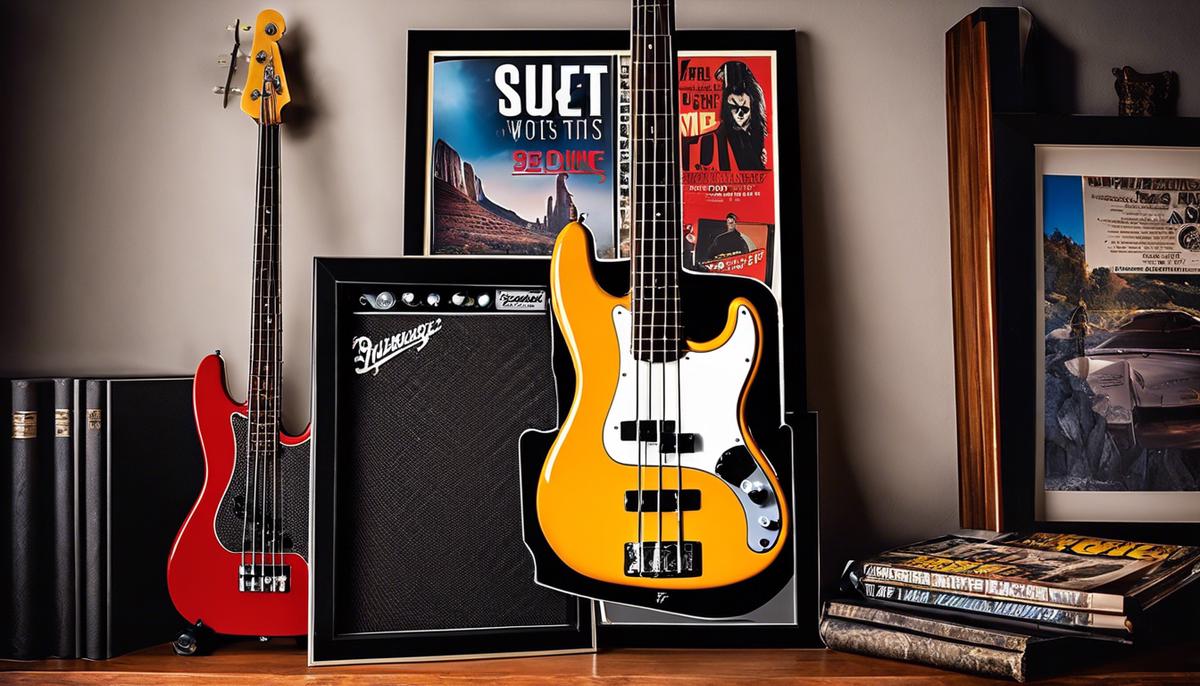Precision Bass: Rock Music’s Backbone
Precision Bass in Rock Music. The electric hum of a Precision Bass is more than just a sonic backbone—it’s a symbol of revolutionary change in rock music. At the hands of Leo Fender in 1951, the Precision Bass emerged not simply as an instrument but as a harbinger of a new era, where the deep, resonant textures of the bass guitar began to challenge the acoustic dominion of its bulky prédécesseur, the double bass.
This exploration into the timbre that shaped a genre starts at the genesis of the Precision Bass, tracing its seismic impact on rock’s soundscape and the musicians who wielded it like a sculptor’s chisel, carving out the contours of rock and roll history.
Table of Contents
The Origin of Precision Bass in Rock
The Groove That Shook the World: How the Precision Bass Revolutionized Rock
When the Precision Bass (P-Bass) first thundered onto the scene in the 1950s, rock music was in its swaddling clothes, cooing for an identity. What it got was a rhythm revolution that would change the face and soul of the genre forever. This isn’t just about an instrument—it’s about a seismic shift; it’s a tale of four strings that pushed rock from the backseat right into the driver’s position.
Before the P-Bass, the thump of the upright bass ruled, but its gentle giant whispers struggled to slice through the burgeoning roar of electric guitars and spirited drums. Enter the P-Bass, with its solid body, steel strings, and magnetic pickups, the brainchild of Leo Fender. The genius wasn’t just in electrifying the bass—it was in precision. The fretted neck meant notes could be played with a missing crispness and accuracy. Bassists everywhere felt the chains fall off. No more hiding in the shadows; it was time to groove in the spotlight with power and confidence.
The Precision Bass did something far more profound than adding low-end muscle—it gave rock music its backbone, its rhythmic heartbeat that you feel in your chest at live concerts. When James Jamerson laid down the groove for Motown’s greatest hits, the P-Bass carried the tune. The fabric of iconic rock—from the Rolling Stones’ gritty anthems to the driving force behind Queen’s anthemic ballads—was woven on the strings of the P-Bass.
Bass lines became riffs that fans hummed, turning the bassist into a rock star. As rock evolved, so did the P-Bass, adapting to the punchy lines of punk, the menacing growl of metal, and the complexity of progressive rock. Flea’s funk-infused acrobatics, Geddy Lee’s technical prowess, and the diverse pallets of musicians like Cliff Burton showed just how versatile the P-Bass could be.
The Precision Bass is more than an instrument—it’s a unifying force that brings the listener, head-banging, into the heart of rock music. Across genres, across the world, the P-Bass continues to be the go-to battleaxe for those ready to lay down the groove that makes crowds cheer, and hearts beat in unison. It doesn’t just play notes; it breathes life into the screaming soul of rock, rolling out the red carpet for a generation of music as diverse as it is united in rhythm and attitude.
So, as fingers dance and pluck the strings of a P-Bass, remember: this isn’t just playing music. This is about creating the pulsing, electrifying soundtrack of a culture, and all it took was four strings and a little precision—rock on.

Iconic Precision Bass Players
Dive deep into the ocean of rock history, and you’ll quickly uncover the titans of the bass guitar.
As indispensable as the heartbeat in a chest, the Precision Bass icons have laid the foundation for countless anthems that defined generations.
Resonating through the ages, the heavy, earth-shaking grooves of John Entwistle from The Who thunders across the soundscape of rock.
Known as “The Ox,” his mastery over the P-Bass cut through the din of guitars and drums, proving the bass was no second fiddle but a frontline force in rock music.
Voyage onward, and you’ll find the funk-rock stylings of Flea from the Red Hot Chili Peppers.
His energetic, slap-bass riffs on the P-Bass are like electrical currents, zapping through the songs and igniting a fire in the souls of listeners.
Flea’s ability to synchronize with the aggression and passion of rock while never losing that elastic funk makes him a beacon in P-Bass history.
The P-Bass also stands tall in the hands of Roger Waters of Pink Floyd.
His sonorous and melodic playing opened portals to ethereal realms, showing that the P-Bass was more than an instrument; it was a craftsman’s tool for sculpting soundscapes.
Waters’ thoughtful lines on classics like “Money” brought a new sophistication to rock bass playing.
Can we talk about P-Bass legends without nodding to the infectious grooves of Dee Dee Ramone from The Ramones?
His raw and relentless attack on the bass strings cultivated the rapid-fire rhythms that spurred the punk movement.
Dee Dee showed that the simplicity of the P-Bass was its strength, driving home the pulse of punk in power-packed punches.
These P-Bass maestros, and many more, not only played their beloved instruments; they channeled life into them, making them extensions of their revolutionary spirits.
Their thunderous notes are the banners under which rock music has marched for decades, and they stand as towering monuments in the pantheon of music history.
So, next time a powerful, precise bass line rumbles through your speakers, tipping the balance of a rock anthem, remember the legends that wielded the Precision Bass with such fire and enthusiasm.
They didn’t just play music; they sparked sonic revolutions that continue to resonate across the world’s heartstrings.

Precision Bass Sound and Technique
Diving further into the vibrant world of rock, the Precision Bass solidifies rhythmic foundations and weaves complex emotional layers within the tapestry of songs. Distinctive sound and playing techniques combine to give the P-Bass its rightful throne in the rock genre.
The P-Bass’s sonic boom resonates with clarity that cuts through the mix, harnessing a thrust that propels rock music forward. It delivers punchy lows and a mid-range growl that can alternately purr or roar within a track. Mastering its soundscape, musicians frame rock’s rhythmic backbone, creating dimensional grooves that resonate in the hearts of listeners.
Playing techniques range from the bassist’s standard fingerstyle to the percussive thump and pop, each producing unique textures that color the genre’s vast sounds. The P-Bass is a chameleon on the stage; it adapts through slap and tap or the gentle caress of a pick, revealing its personality and accentuating the attitude of rock.
Its solid body design and comparatively shorter neck make the P-Bass a friend of fleet fingers and sweaty, stage-bound hands. It’s the ally to the leaping bassist who punctuates the air with notes as visual as audible. When a P-Bass player digs in, the strings answer with a biting clarity, often providing the heartbeat to our most beloved anthems.
The P-Bass fosters a legacy, shepherding in novelties that reshape the rock realm. The instrument’s readiness to resonate with effect pedals pushes the boundaries of the traditional rock bass tone. Experimenting with fuzz, wah, and chorus, artists reinvent and revitalize soundscapes, ensuring that rock remains an evolving beast of expression.
Lastly, the P-Bass’s contribution extends into the ethos of collaboration. The meaty tones blend harmoniously with the fierce lead guitar and the steadfast drums, locking in to fuel the synergy erupting on stage. Brothers and sisters in arms, bassists wielding the P-Bass bind together the elements of rock, forging anthems that bring people to their feet, all while holding within its strings the history and future of rock and roll.

Precision Bass Design Evolution
Moving onward in the grand odyssey of the Precision Bass, we delve into the realm of its physical evolution — a journey marked by craftsmanship that echoes the pulse of eras it has traversed. Unlike a river that adapts to the landscape, the P-Bass design has flowed and morphed, ensuring its musicians aren’t simply playing notes but are invoking a distinct voice within the tapestry of music.
Originally birthed in a 1951 prototype, the P-Bass represented a revolution. Its solid body was a stark departure from its hollow-bodied ancestors and wore simplicity like a badge of honor. Yet, in the years to follow, the Precision Bass truly began to shape-shift, as though the instrument itself was a living creature evolving to its environment.
The mid-50s saw the P-Bass don a contoured body, a tactile enhancement that hugged the musician’s form, allowing the infectious grooves to flow uninhibited. By 1957, the iconic split-coil pickup made its premiere, a game changer that reduced hum and granted the bass even more of its signature warmth and clarity—a trait that would make it a favorite among blues and soul artists.
As rock ‘n’ roll thundered through the ’60s and ’70s, the P-Bass kept in lockstep with the genre’s magnified vigor. Modifications in neck design — moving from a chunky, substantial “C” shape to the more streamlined “A” shape — allowed for deft, fleet-fingered maneuvers, satisfying the needs of bassists who were as much performers as they were musicians. These adjustments in the neck profile tailored the P-Bass to be an extension of the artist’s body, making for an intuitive bond between the human and the instrument.
The palette of the P-Bass expanded with ever-changing tastes in sound. New finishes and color schemes let the P-Bass don as many costumes as personalities rocked it on stage. Options like fretless models opened doors to a universe of new textures, from jazz’s smooth, glissando lines to the percolating grooves of world music, illustrating its chameleon-like versatility.
Electronics further evolved. While the fundamental tone of the P-Bass remained rooted in its heritage, the introduction of active pickups and preamps in the later ’80s models offered bassists not just volume, but a spectrum of sonic varieties. With these modifications, the P-Bass emerged as an engineer’s muse, ripe for myriad effects to sculpt sounds that defied genre confines, from the fuzzy grit of garage rock to the space-defying echoes of progressive rock.
The bridge stands at the intersection of all these changes — often taken for granted, yet central to the instrument’s character. From the two-saddle bridge of the early days to the high-mass bridges of the modern era, this unassuming component has been the unsung hero in defining sustain and resonance, giving P-Bass players a reliable anchor for their strings and their sound.
In every incarnation, from its magnetic pickups to the very wood from which it’s carved, the P-Bass has not just adapted to the diverse sonic landscapes of music but has been the bedrock upon which the same landscapes were built. It’s a testament to the foresight of its creators and to the boundless spirit of the musicians who have chosen it as their comrade-in-arms on the battlefield of creation.
With each redesign, upgrade, and tweak, the Precision Bass remains relevant and integral—fueling the ingenuity of bassists who push the boundaries of rhythm, harmony, and what it means to rock truly.

Precision Bass in Contemporary Rock
Taking the stage with a legacy of strings vibrating through the ages, the Precision Bass continues to hold its ground in today’s rock world. Where does it stand amongst contemporary musicians’ and producers’ complex structures and sonic landscapes? Its presence is as vigorous as the pounding hearts of festival-goers eagerly awaiting that drop—the one where the bass cleaves through the din like a beacon, regardless of a band’s experimental cues or electronic infusion.
Looking at the modern rock scene, one can witness new breeds of artists weaving intricate tapestries of sound where digital and analog intertwine. Yet amidst this innovation, the P-Bass holds its own—it’s that steady thump in the indie band’s heartfelt anthem, the guttural growl behind the metal group’s seismic riffage. The resilience in the P-Bass makes each note a declaration, a staple in the arsenal of low-end warriors, from garage rock revivalists to the polished stadium fillers.
The P-Bass’s sound may be classic, but it’s anything but outdated. It’s the backbone for boundary-pushing genres like math rock, with jagged time signatures and complex compositions that demand a bass that can punch with precision yet dance with finesse. Up-and-comers and established musicians tweak their P-Basses with upgraded hardware, exotic strings, and personalized mutations. They may be steeped in heritage, but these axes are hot-rodded for the future, capturing a sound as contemporary as it is timeless.
Take it from the rough-and-tumble punk rock scene—the P-Bass is the weapon of choice for its robust build, quickly cutting through distorted guitars like a razor. Conversely, in the artful world of shoegaze and post-rock, where textures are king, the P-Bass lays down a statelier rumble. It grounds ethereal soundscapes in earthly vibrations, reminding us that the sonic universe has a center of gravity.
And let’s not overlook the trendsetters who use the P-Bass as a canvas for sonic exploration. They flip the script on tradition by pairing this storied instrument with synths and drum machines. It’s a marriage of old-school groove with new-wave tech, gracing genres like electro-pop and digital rock with a revered touch from the past.
The unyielding character of the P-Bass is also in how it nestles comfortably in the hands of players from every walk of life, from the grizzled vet who’s strummed the same four strings for decades to the eager newbie with a heart whole of beats and a YouTube education. This is no elitist artifact—it’s a rallying cry calling to anyone who wants to shake the ground and move the masses.
In this era of ever-shifting musical paradigms, the question isn’t whether the Precision Bass is still relevant—it’s more about how the music world would manage to spin on without it. After all, when a foundation as strong as that provided by the P-Bass has been laid, it’s not just about staying relevant. It’s about being indispensable, both a relic and a revelation, a testament to the true spirit of rock and beyond.

The resonant strings of the Precision Bass continue to vibrate through the heart of rock music, undiminished by the passage of time. As we’ve journeyed from its birth in Leo Fender’s pioneering vision to the diverse stages of contemporary rock, the Precision Bass is a testament to innovation, versatility, and the tireless pursuit of musical excellence.
Rock’s landscape evolves, yet the indomitable spirit of the Precision Bass endures, its notes and nuances forever interwoven into the dynamic tapestry of a genre that refuses to stand still.


